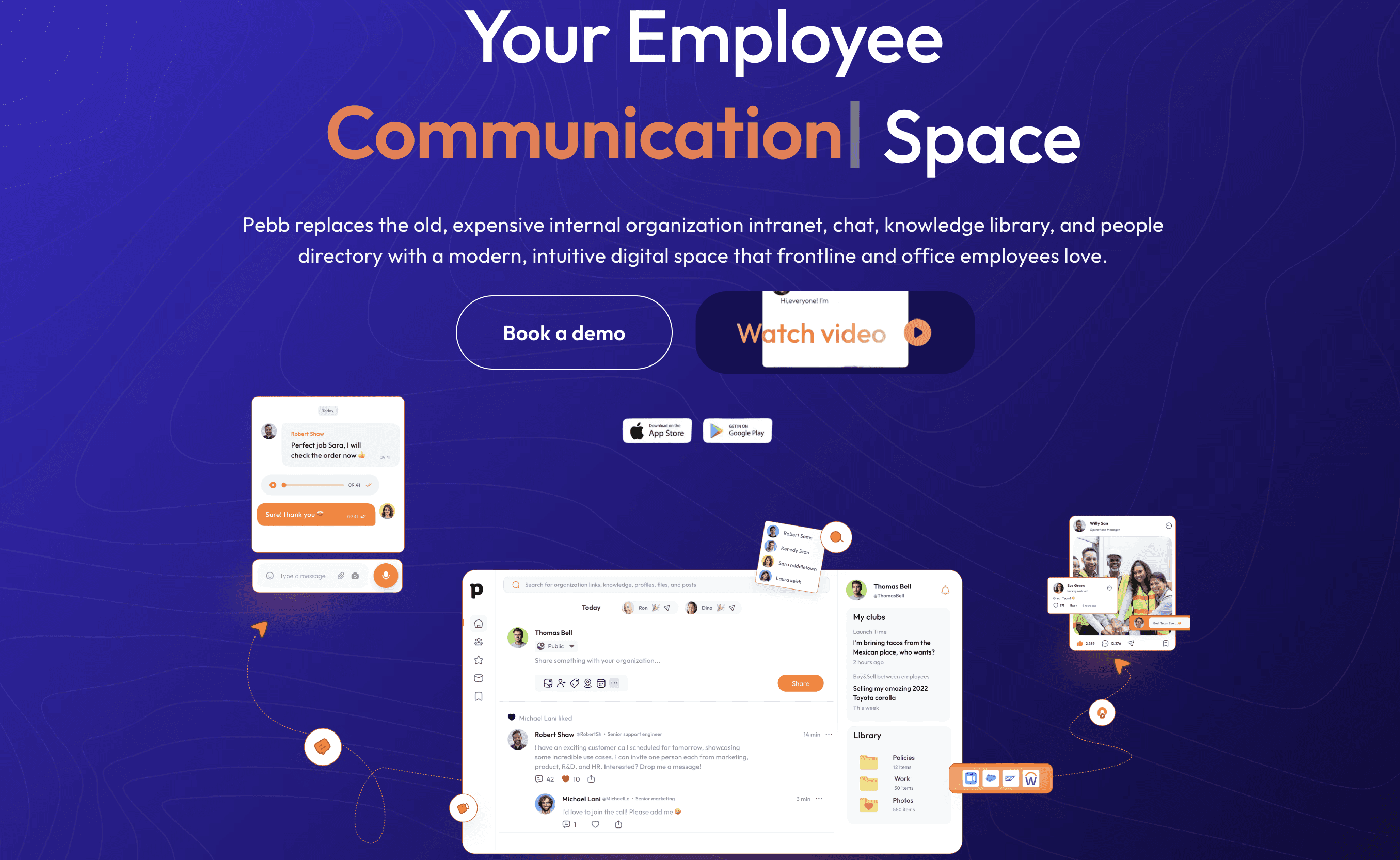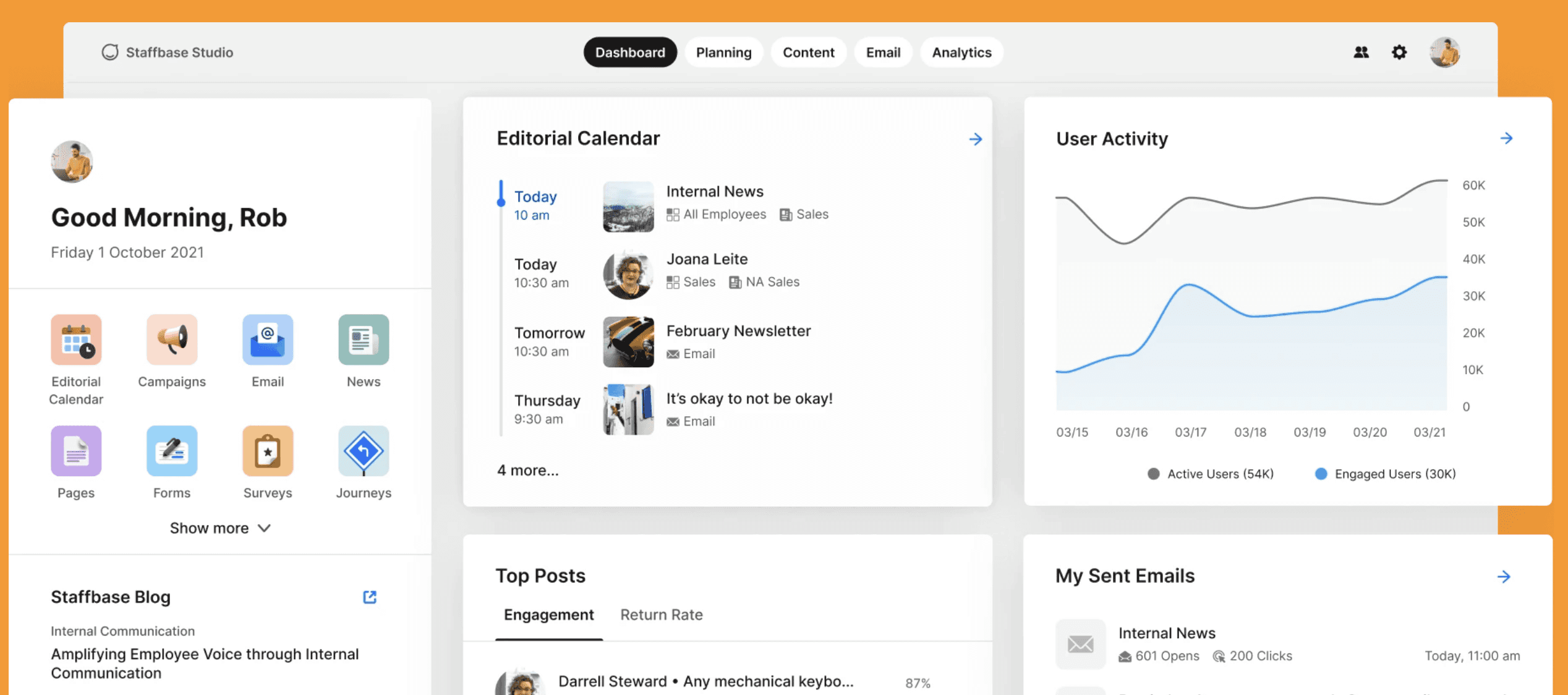Meta Workplace Alternatives: 5 Solutions to Consider in 2024
21 août 2024
James Dean
The digital workplace landscape is undergoing a significant transformation, especially with the recent announcement that Meta Workplace will be closing its doors in 2024. For many organizations, Meta Workplace has been a cornerstone of internal communication, engagement, and collaboration since its launch in 2016. Its familiar, social media-like interface made it easy for employees to adopt, bringing a new level of connectivity to teams across industries. But as the platform winds down, businesses are now left with a critical decision: what comes next?
In this blog, we’re diving deep into the top alternatives to Meta Workplace (here's a short summery about Meta Workplace history, main features and use cases) that are shaping the future of digital collaboration in 2024. Whether you're a long-time user of Meta Workplace looking for a new home or an organization just beginning to explore digital workplace solutions, these platforms offer a wealth of features designed to enhance communication, engagement, and collaboration within your team.
We’ll explore five standout options—Pebb, Happeo, Workvivo, Yammer/Microsoft Viva Engage, and Staffbase—each bringing unique strengths to the table. From robust news feeds and comprehensive communication tools to seamless integrations and mobile-first designs, these platforms are leading the charge in creating more connected, productive workplaces. We'll delve into their key features, pricing, and any potential drawbacks, helping you make an informed decision as you transition to a new platform.
1. Pebb: The Ultimate Communication and Engagement Platform

When it comes to replacing Meta Workplace, Pebb is not just an alternative—it’s a complete upgrade. Designed to be a holistic solution for communication, engagement, and collaboration, Pebb has quickly become the go-to platform for organizations looking to foster a vibrant, connected work environment. Whether your team is spread across offices or operating on the frontlines, Pebb provides the tools you need to keep everyone on the same page.
Key Features:
News Feeds: Pebb’s dynamic news feeds ensure that every team member is updated with real-time information, making it easier to stay aligned with company goals and announcements.
Profiles: Pebb's profiles go beyond the standard directory, offering an interactive platform where employees can highlight their skills, experiences, and professional journeys. This feature promotes transparency and helps teams better understand each other’s strengths.
Secure Instant Chat Messaging: Communication is key, and Pebb delivers with secure, private messaging that protects sensitive information while facilitating quick and easy exchanges.
Private Clubs: Whether for department-specific discussions or cross-functional project collaboration, Pebb’s private clubs offer a dedicated space for focused communication, ensuring that conversations are organized and productive.
Knowledge Library: With Pebb's Knowledge Library, important documents and resources are centralized for easy access. The ability to create image galleries adds a visual element that enhances information sharing.
Apps Wall: Pebb’s centralized hub integrates all your organization’s digital tools into one interface, streamlining workflows and increasing overall productivity.
Pricing:
Pebb is as cost-effective as it is feature-rich. The platform offers a free plan that can support any company size, making it accessible for organizations at every scale. For those seeking additional features, Pebb’s premium plan is available at just $2 per user per month, positioning it as one of the most affordable options in the market.
Cons:
Learning Curve: New users may find Pebb’s comprehensive feature set a bit overwhelming at first, particularly those coming from simpler platforms.
Customization Options: While Pebb offers a wide range of features, customization options for branding and interface design are somewhat limited compared to other platforms.
Why Pebb?
Pebb is ideal for organizations that value a strong sense of community and need a platform that supports both communication and engagement. Its mobile-first design ensures that even frontline workers can stay connected, and its pricing makes it accessible to businesses of all sizes. If you’re looking to go beyond what Meta Workplace offered, Pebb is a solution that will not only meet but exceed your expectations.
2. Happeo: Google-Integrated Social Intranet

For companies that have fully embraced the Google Workspace ecosystem, Happeo presents a seamless integration that enhances internal communication and collaboration. As a social intranet platform, Happeo combines the functionality of Google tools with a user-friendly interface, making it a powerful alternative to Meta Workplace.
Key Features:
Google Integration: Happeo’s deep integration with Google Workspace means that your team can collaborate effortlessly using tools like Google Drive, Calendar, and Gmail, all within the Happeo interface.
Page Builder: Happeo’s template-based page builder allows organizations to create custom intranet pages and employee content without needing extensive technical expertise.
Communities and Channels: Happeo enables users to create specialized hubs and communities, whether based on departments, roles, or shared interests, fostering a sense of belonging and collaboration.
Search Functionality: The platform’s powerful search tool allows users to quickly locate people, posts, and even data from integrated third-party apps, streamlining the information retrieval process.
Pricing:
Happeo's pricing is available upon request. The platform is known for offering competitive rates, especially for organizations already utilizing Google Workspace. The flexibility in pricing makes Happeo an attractive option for businesses of various sizes.
Cons:
Customization Limitations: While Happeo is highly functional, its customization options for interface design and notifications are somewhat limited, which might be a drawback for companies seeking a highly tailored experience.
Analytics Delay: Some users report a time delay in Happeo’s analytics, which can make it challenging to gain real-time insights into user engagement and content performance.
Why Happeo?
Happeo is a smart choice for organizations that are deeply integrated into the Google ecosystem. Its user-friendly design and powerful collaboration tools make it easy to adopt and use, while its strong search functionality ensures that information is always at your fingertips. If Google Workspace is at the heart of your organization, Happeo is a natural extension that will enhance your digital workplace.
3. Workvivo: The Employee Experience Platform

has rapidly emerged as a leader in the employee experience space, particularly after its acquisition by Zoom. This platform is designed to foster connection, engagement, and alignment across your organization, making it a compelling alternative to Meta Workplace.
Key Features:
Diverse Communication Channels: Workvivo supports a wide array of communication methods, including news feeds, 1:1 chats, live streams, and podcasts, catering to different preferences and enhancing overall engagement.
Integration with Zoom: One of Workvivo’s standout features is its seamless integration with Zoom, making it an excellent choice for organizations with a remote or hybrid workforce.
Microsites: Teams and special interest groups can create their own microsites, allowing for focused collaboration and community building within the larger organization.
Translation Capabilities: Workvivo’s built-in translation features support multilingual teams, ensuring that content is accessible to all employees, regardless of language barriers.
Pricing:
Workvivo’s pricing is available on request, but it’s worth noting that some advanced features, such as Workvivo TV and detailed analytics, come at an additional cost. This pricing structure positions Workvivo as a more premium option compared to some of the other alternatives.
Cons:
Cost: The additional costs for premium features can make Workvivo a more expensive option, which may not be ideal for organizations with limited budgets.
Limited Personalization: Users may find the platform’s personalization options to be somewhat restricted, limiting their ability to fully customize the interface and notifications to suit their specific needs.
Notification Overload: Some users report that excessive notifications from Workvivo can be disruptive, potentially hindering productivity rather than enhancing it.
Why Workvivo?
Workvivo is particularly well-suited for organizations looking to enhance their employee experience through diverse and engaging communication channels. Its integration with Zoom makes it a powerful tool for remote and hybrid teams, and its focus on community building helps to foster a strong sense of belonging within the organization. If employee engagement is a top priority, Workvivo is a platform that should be at the top of your list.
4. Yammer / Microsoft Viva Engage: The Microsoft Ecosystem Solution

For organizations already invested in the Microsoft suite of tools, Yammer—now part of Microsoft Viva Engage—offers a natural extension of their digital workplace. As an enterprise social network, Yammer facilitates open communication and community building within large organizations, while its integration with other Microsoft products enhances overall productivity.
Key Features:
Microsoft Integration: Yammer/Viva Engage integrates seamlessly with other Microsoft tools like Teams, SharePoint, and Outlook, providing a cohesive experience that enhances productivity across the board.
Communities and Groups: Employees can join or create communities based on shared interests or job roles, enabling knowledge sharing and collaboration across departments.
Virtual Town Halls: Host large-scale virtual events with Yammer’s video and Q&A features, ensuring that all employees—whether remote or in the office—can participate in important company conversations.
AI-Powered Insights: Microsoft’s AI capabilities provide valuable insights into employee engagement, content relevance, and communication effectiveness, helping organizations refine their strategies.
Pricing:
The full suite of Microsoft Viva tools, including Viva Engage, is priced at $12 per user per month, with an annual commitment required. This price point, which does not include GST/VAT, makes Yammer a significant investment, especially when combined with the cost of other Microsoft products required to build a complete intranet.
Cons:
Interface Complexity: Some users find the Yammer/Viva Engage interface to be less user-friendly, particularly when it comes to navigating the mobile app version.
Unfiltered Communications: Without comprehensive content filtering options, content in Yammer’s news feed can sometimes be overwhelming and irrelevant to individual users, leading to a less personalized experience.
Notification Overload: Similar to Workvivo, users often report receiving too many email notifications from Yammer, which can be distracting and reduce productivity.
Why Yammer/Viva Engage?
Yammer/Viva Engage is an excellent choice for organizations that are already using Microsoft products. Its seamless integration with the Microsoft ecosystem makes it easy to adopt and ensures that all tools work together harmoniously. If your organization relies heavily on Microsoft tools and needs a robust platform for communication and community building, Yammer/Viva Engage offers a comprehensive solution.
5. Staffbase: The Employee Communication Powerhouse

is a leading platform focused on improving employee communication across all levels of an organization. With a strong emphasis on connecting both office and frontline workers, Staffbase provides a suite of tools designed to unite your workforce and streamline internal communication efforts.
Key Features:
Multi-Channel Communication: Staffbase supports a variety of communication channels, including email, messaging, and chat, making it easy to reach employees wherever they are, regardless of their location or role.
Intranet and Employee App: Staffbase’s intranet solution serves as a central hub for all company information, while its employee app ensures that even frontline workers have access to the resources they need.
Content Planning and Analytics: Staffbase offers powerful tools for planning and analyzing communication campaigns, helping organizations refine their messaging and improve employee engagement over time.
HR Integration: The platform integrates seamlessly with HR tools, providing self-service options for employees and simplifying HR operations, such as onboarding and benefits management.
Pricing:
Staffbase’s pricing is available upon request, but it is generally considered to be on the higher end of the spectrum. Additional modules and features may come at an extra cost, making it a significant investment for organizations that want to use the platform to its fullest potential.
Cons:
High Cost: The premium pricing and additional costs for extra modules may be prohibitive for smaller organizations or those with tight budgets.
Mobile App Setup: While Staffbase offers a mobile app, it can take time to set up, particularly because there are limited out-of-the-box features specifically for frontline workers.
Limited Customization: Some users have noted that customization options within the platform are somewhat limited, particularly when it comes to branding and interface design.
Why Staffbase?
Staffbase is particularly well-suited for large organizations with a diverse workforce, including both office-based and frontline employees. Its focus on multi-channel communication ensures that all employees can stay connected and informed, while its robust analytics help organizations measure the impact of their communication efforts. If you're looking for a comprehensive platform that can unify your organization's communication strategy, Staffbase is a strong contender.
Meta Workplace Closure: A New Era in Digital Collaboration
The closure of Meta Workplace, announced in May 2024, marks a pivotal moment in the evolution of digital workplace tools.
Launched in 2016, Meta Workplace brought social media-style communication into the corporate world, offering an intuitive and familiar interface that many organizations quickly adopted. However, as the platform sunsets, it underscores the importance of adaptability and continuous innovation in the digital workplace.

The shutdown of Meta Workplace has left many organizations searching for a new platform that can not only replace its functionality but also offer advanced features that cater to the modern, hybrid workforce. The alternatives highlighted in this blog—Pebb, Happeo, Workvivo, Yammer/Microsoft Viva Engage, and Staffbase—are leading the way in this space, providing robust solutions that enhance communication, engagement, and collaboration.
Summary: Choosing The Best Workplace Alternative
As you consider the best alternative to Meta Workplace for your organization, it’s essential to weigh the unique needs of your team against the features and capabilities of each platform. Whether you’re drawn to Pebb’s all-encompassing approach to communication and engagement, Happeo’s seamless integration with Google Workspace, Workvivo’s focus on employee experience, Yammer/Viva Engage’s deep Microsoft integration, or Staffbase’s comprehensive communication tools, each platform offers distinct advantages that can help your organization thrive in 2024 and beyond.
Remember, the right platform is one that not only meets your current needs but also scales with your organization as it grows and evolves. With Meta Workplace closing, now is the perfect time to explore these alternatives and find the solution that will best support your team’s communication, engagement, and collaboration efforts for years to come.
Read more about Meta Workplace Shuts Down here.





